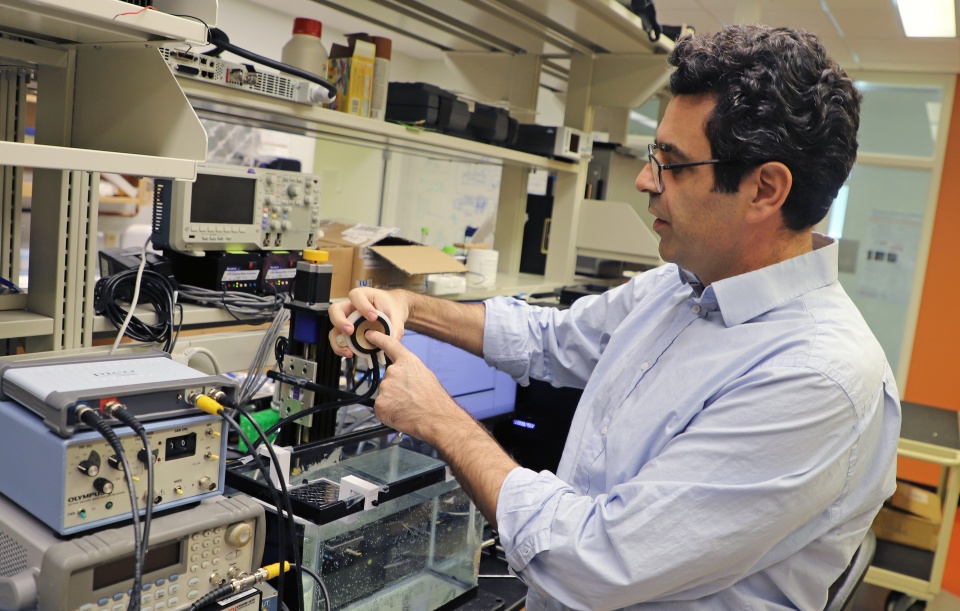Unlocking the Brain: Using Microbubbles and Ultrasound for Drug Delivery

Costas Arvanitis is developing a method using microbubbles and ultrasound to breach the blood-brain barrier. — Photo by Jerry Grillo
The brain is a stronghold, the central command center for the body, protected by the blood-brain barrier (BBB). This network of blood vessels and tissues acts as a biological gatekeeper, a selective filter that prevents harmful substances in the bloodstream from entering the brain’s complex ecosystem.
It’s protection that comes at a cost. While the BBB lets some things in — like water, oxygen, general anesthetics made of very small molecules — it also prevents many vital therapeutics from reaching the brain, limiting the treatment options for neurological problems.
But a multinational team of researchers led by Georgia Tech biomedical engineer Costas Arvanitis is tackling the challenge with a technique that combines microbubbles — tiny gas-filled spheres — and ultrasound technology. Their innovative approach aims to temporarily open the BBB, allowing drugs or immune cells in to take on the fight against disease, offering therapeutic hope for patients battling conditions like brain cancer or Alzheimer’s disease.
“We found that microbubble-enhanced ultrasound, an emerging technology that offers a noninvasive way to temporarily open the blood-brain barrier, allows blood-borne therapeutics to reach the brain,” said Arvanitis, associate professor in the Wallace H. Coulter Department of Biomedical Engineering and the George W. Woodruff School of Mechanical Engineering.
The technique can potentially be fine-tuned to establish windows of opportunity to target brain diseases, he added. Costas and his collaborators describe their work in a recent edition of Nature Communications.
Bouncing Bubbles
Microbubbles, smaller than the diameter of human hair, have shells made of a lipid or protein. In healthcare, they’re often used to help enhance visibility in ultrasound, acting as contrast agents, illuminating details inside the body.
Ultrasound uses high-frequency sound waves to create images. When microbubbles are exposed to focused ultrasound waves, they rapidly expand and contract. This gentle mechanical force shakes the protective barrier surrounding the brain, creating small openings for aid to pass through.
“Despite their simple structure, microbubbles have complex behaviors,” Arvanitis said. “They can resonate at specific frequencies, allowing us to manipulate their oscillations to enhance permeability at the blood-brain barrier. And their behavior also depends on their size and shell composition.”
For instance, microbubbles with elastic shells are more effective in increasing the permeability of the BBB. In their research, Arvanitis and his collaborators noted a 12-fold increase in drug delivery effectiveness using elastic-shelled (lipid-based) microbubbles.
Math Before Mice
The researchers conducted studies using mice but began with a mathematical model to simulate microbubble dynamics in brain vessels. They identified a resonant frequency that enhances microbubble movement and explored the correlation between frequency, bubble dynamics, and inflammatory responses in the brain.
Their model and later experiments showed that specific ultrasound frequencies can enhance immune cell movement and increase drug accumulation in brain tumors. They also found that higher ultrasound frequencies, while effective in opening the BBB, were also accompanied by increased expression of inflammatory markers on the endothelia cells of the BBB — an important finding, as excessive inflammation can lead to further complications in patients with neurological disorders.
"By understanding and controlling the frequency dynamics of microbubbles, we can create a system that maximizes drug delivery efficacy,” Arvanitis said. “Our findings suggest that using lower frequencies may be beneficial for delivering therapeutics while reducing inflammation, which can be crucial for treating neurodegenerative diseases like Alzheimer's and Parkinson's.”
The research has implications that could extend beyond drug delivery, paving the way for new diagnostic techniques. Using ultrasound to open the BBB could allow clinicians to gather important information directly from the brain, improving diagnostic techniques, like ultrasound-enhanced biopsies.
“The scientific principles established by our work not only enhance our ability to develop safer and more effective treatments for brain diseases, but also lays the groundwork for innovative diagnostic and therapeutic strategies within and beyond the brain,” said Arvanitis, whose team included graduate students from his lab as well as researchers from the University of California (San Francisco), Stanford, and the University of Edinburgh.
He added, “The dynamics of microbubbles interacting with blood vessels could have important implications in other areas of medicine that we haven’t yet explored.”
CITATION: Yutong Guo, Hohyun Lee, Chulyong Kim, Christian Park, Akane Yamamichi, Pavlina Chuntova, Marco Gallus, Miguel Bernabeu, Hideho Okada, Hanjoong Jo, Costas Arvanitis. “Ultrasound frequency-controlled microbubble dynamics in brain vessels regulate the enrichment of inflammatory pathways in the blood-brain barrier.” Nature Communications doi.org/10.1038/s41467-024-52329-y
FUNDING: This study was supported by NIH grants R37 CA239039, R01CA273878, R35NS105068, HL119798, HL139757, HL151358, and T32HL166146. This study was also supported by the Parker Institute for Cancer Immunotherapy, Ians Friends Foundation, and the German Research Foundation, and the Leducq Foundation.